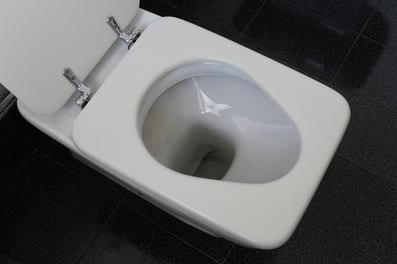 Tired of the sound of your toilet running long after you flush it? Not only is this common household plumbing issue annoying, but it can waste up to 200 gallons or more of water in a single day. That comes out to about wasted 6,000 gallons a month—waste that you have to pay for!
Tired of the sound of your toilet running long after you flush it? Not only is this common household plumbing issue annoying, but it can waste up to 200 gallons or more of water in a single day. That comes out to about wasted 6,000 gallons a month—waste that you have to pay for!
Thankfully, a running toilet is often a simple and inexpensive fix that many cases you can handle yourself. So stop throwing your money down the toilet and get ready for a little DIY home maintenance:
First, what’s inside your toilet tank
When you take the top off of your toilet tank, it’s important to understand what you’re looking at. A toilet is a relatively simple plumbing system, but it can be a little confusing at first glance. Here’s what’s inside and what each part does.
Parts involved with the flushing process:
- Handle arm and chain. This simple mechanism consists of a long arm and a chain that’s connected to the flapper. When you push down on the outside handle, the chain lifts the flapper.
- Flapper. This rubber seal or ball covers the opening at the bottom of the tank. When it’s lifted, it allows water to rush into the toilet bowl, clearing away waste with the help of gravity. The flapper closes after a few seconds and should seal tightly.
Parts involved in refilling the bowl and tank:
- Fill valve. Sometimes called a ballcock, this tall shaft is the entry point for fresh water. A simple valve on the top of the shaft shuts off the water when the float (see below) reaches the proper angle.
- Fill tubes. Two narrow tubes come out of the fill valve: one to fill the tank (this one may be hidden) and one to refill the bowl below. This second, more obvious tube extends down into the overflow pipe and into the bowl.
- Overflow tube. This tall pipe is the way that fresh water gets into the bowl after the flapper has sealed. Water from the fill valve flows through a tube and down into the bowl until it shuts itself off. The overflow tube has an open top that serves as a safety backup—if the water level in the tank rises above the top of the pipe, it will flow down into the bowl instead of over the top of the tank.
- Float. In older-style toilets, this is the most recognizable part—a large plastic bladder that sits on the surface of the water, connected to the fill valve with an arm. Alternatively, the float may be a plastic mechanism that hugs the tall fill valve. Both types do the same thing—float on the top of the water until the water level reaches the predetermined fill line. When it’s in the right spot, the fill valve shuts off, stopping the water flow to both the bowl and the tank.
What causes a toilet to run
When a toilet runs, the issue is with water continuing to flow into the bowl and tank, instead of shutting off as it’s supposed to. Now that you know how a toilet basically works, it’s easy to see some of the common causes:
- The chain is the wrong length. Whether it’s just gotten twisted or has been damaged, a chain that’s too short won’t allow the flapper to close properly, allowing water to leak into the bowl.
- Solution: Readjust the chain manually, or replace it.
- The flapper isn’t sealing properly. Aging rubber may compromise the seal.
- Solution: Replace the flapper.
- The float is set for an incorrect fill level. If your float is set for too high a level, it won’t shut the valve off in time, and water will continue to flow through the top of the overflow tube in a never-ending cycle.
- Solution: Sometimes the float arm can be adjusted with its connecting screw, or the arm may be carefully bent into the correct place.
- A seal may be worn out. Old seals at the bottom of the overflow tube or fill valve can cause water to leak.
- Solution: replace the seals.
- The fill valve isn’t working properly. Perhaps the float reaches the correct level, but the valve just doesn’t shut off for some reason.
- Solutions: You can try disassembling the valve (after shutting the water off!) and rinsing out any debris. If that doesn’t work, check for any worn parts. If replacing those doesn’t help, the whole unit may just need to be replaced. (This may require you to call an experienced plumber for help.)
How to replace parts in a running toilet
Important note: Before taking anything out of your toilet, shut off the water first! You’ll most likely find the shut-off valve handle behind the toilet on the wall. To do some replacement or repair work, you may want to drain the tank by flushing one more time after the water is off.
If you’ve read our articles about fixing a tub drip or a leaky kitchen faucet, this part should sound familiar. Disassemble the worn parts, making careful note of what order they go in. Take the old parts to your local home improvement store and be sure to get an exact match.
Then come home, reassemble, and voilà! Your commode is back in business—this time, without the noisy water waste.
Help is available 24/7
Stumped? Encounter a larger problem? Or just ready to replace an old toilet with something newer, more efficient, and less temperamental? Give Ken’s a call at (864) 242-5511 or contact us online.


.png)